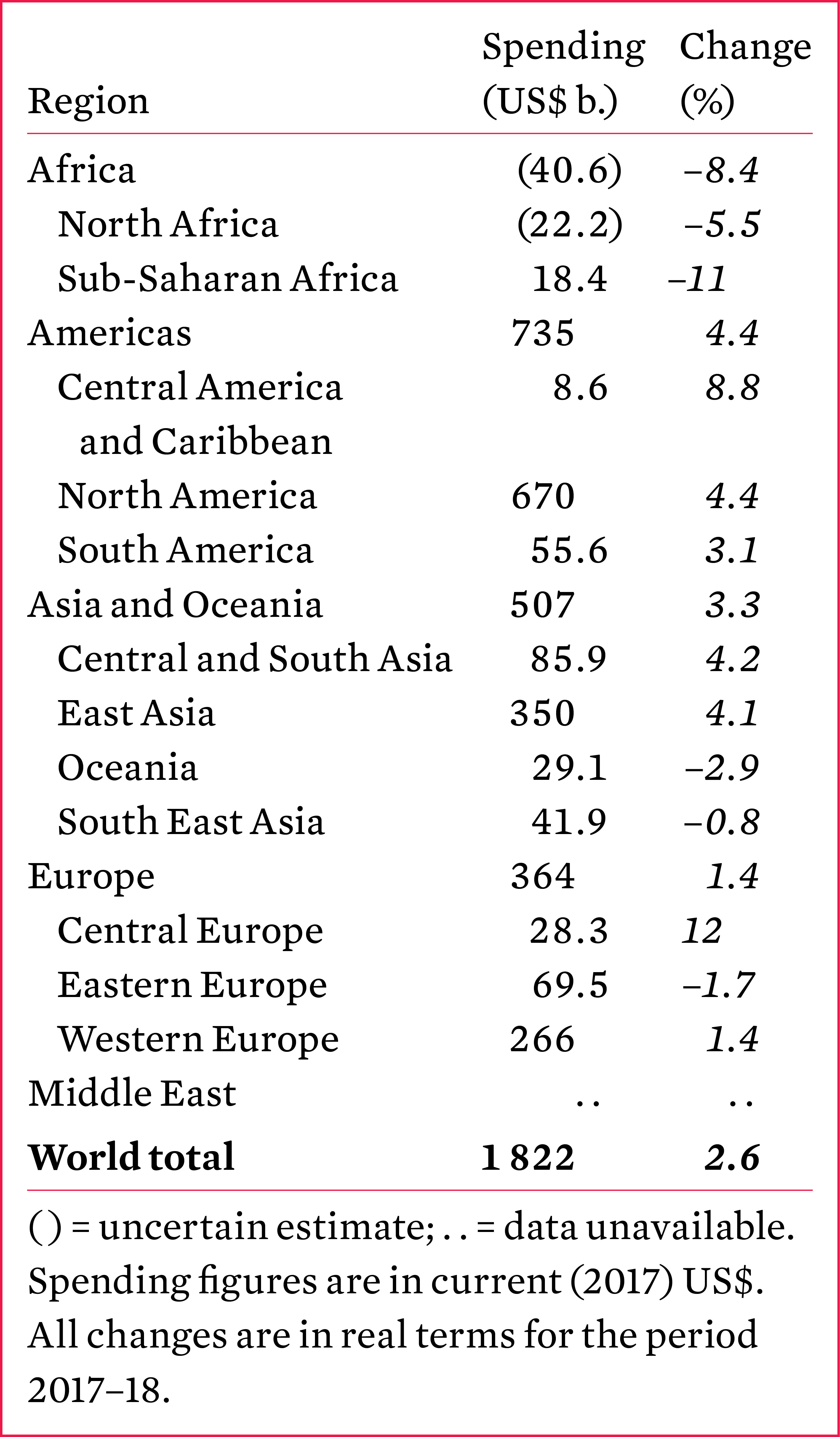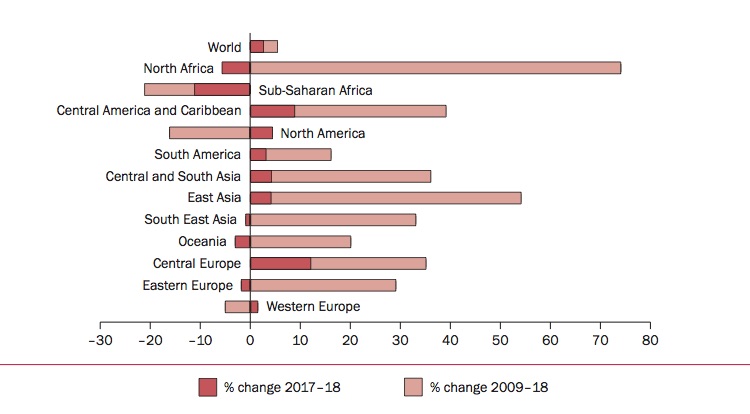4. Military expenditure
World military expenditure is estimated to have been $1822 billion in 2018, accounting for 2.1 per cent of world gross domestic product (GDP) or $239 per person. Total expenditure grew for the second consecutive year and exceeded $1.8 trillion for the first time; it was 2.6 per cent higher than in 2017 and 5.4 per cent higher than in 2009.
The growth in total spending in 2018 was largely influenced by expenditure patterns in the Americas and Asia and Oceania, in particular by substantial rises in military expenditure by the United States and China. In Europe, spending grew by 1.4 per cent, mostly due to a rise in expenditure in Western Europe, where all but three countries increased spending. Military expenditure decreased in Africa, by 8.4 per cent. For the fourth successive year, SIPRI cannot provide an estimate of total spending in the Middle East, but the combined military expenditure of the 11 Middle Eastern countries for which data is available decreased by 1.9 per cent.
The military burden—military spending as a share of GDP—fell between 2017 and 2018 in all regions except Europe, where there has been a push by member states of the North Atlantic Treaty Organization (NATO) to reach the guideline spending level of 2.0 per cent of GDP by 2024. On average, states in the Americas had the lowest military burden in 2018, at 1.4 per cent of GDP; this rises to an average of 1.6 per cent in Europe, 1.7 per cent in both Africa and Asia and Oceania, and 4.4 per cent in the Middle Eastern countries for which data is available.
The five biggest spenders in 2018 were the USA, China, Saudi Arabia, India and France, which together accounted for 60 per cent of global military spending.

The USA increased its military spending for the first time in seven years to reach $649 billion in 2018. Spending by the USA accounted for 36 per cent of world military spending and was 2.6 times more than the next highest spender, China. The rise in US military spending can be attributed to two factors: a 2.4 per cent increase in the salaries of military personnel; and the implementation of large and costly conventional and nuclear arms acquisition programmes.
China allocated an estimated $250 billion to its military in 2018. This represented a 5.0 per cent increase compared with 2017 and an 83 per cent increase since 2009. China’s military spending is roughly linked to the country’s economic growth, which slowed in 2018 to the lowest level in 28 years. Slower growth in military spending can therefore be expected in the coming years.
Saudi Arabia had the highest military burden in the world at 8.8 per cent of GDP in 2018. Its military spending fell by 6.5 per cent in 2018 to $67.6 billion. India ($66.5 billion) and France ($63.8 billion) were the fourth- and fifth-highest spenders in the world in 2018.
At $61.4 billion, Russian military spending in 2018 had fallen by 22 per cent from its post-cold war peak in 2016, and Russia was ranked outside the top five military spenders for the first time since 2006.
The three biggest relative increases in military spending between 2017 and 2018 were by Burkina Faso (52 per cent), Jamaica (40 per cent) and Armenia (33 per cent), while the three largest relative decreases were by South Sudan (50 per cent), Sudan (49 per cent) and Benin (28 per cent).

Transparency in military expenditure
The decline in responses to the United Nations Report on Military Expenditures continued in 2018. Having peaked at 81 responses in 2002, in 2018 only 36 of the 193 UN member states submitted a report on their military expenditure. In contrast, at the national level, data was obtained for 155 of the 168 countries for which SIPRI attempted to collect military expenditure information for 2018. The data came from official government documents for 150 of these.
Transparency in military spending requires not only public availability of data, but also comprehensiveness, ease of access and details on the various types of funding of military activities. Disaggregation of military budgets into military and non-military activities is an important step towards improving transparency in military expenditure. According to a case study on Brazil, accurate disaggregation of resources allocated to the military for police tasks improves the accuracy of military spending data.